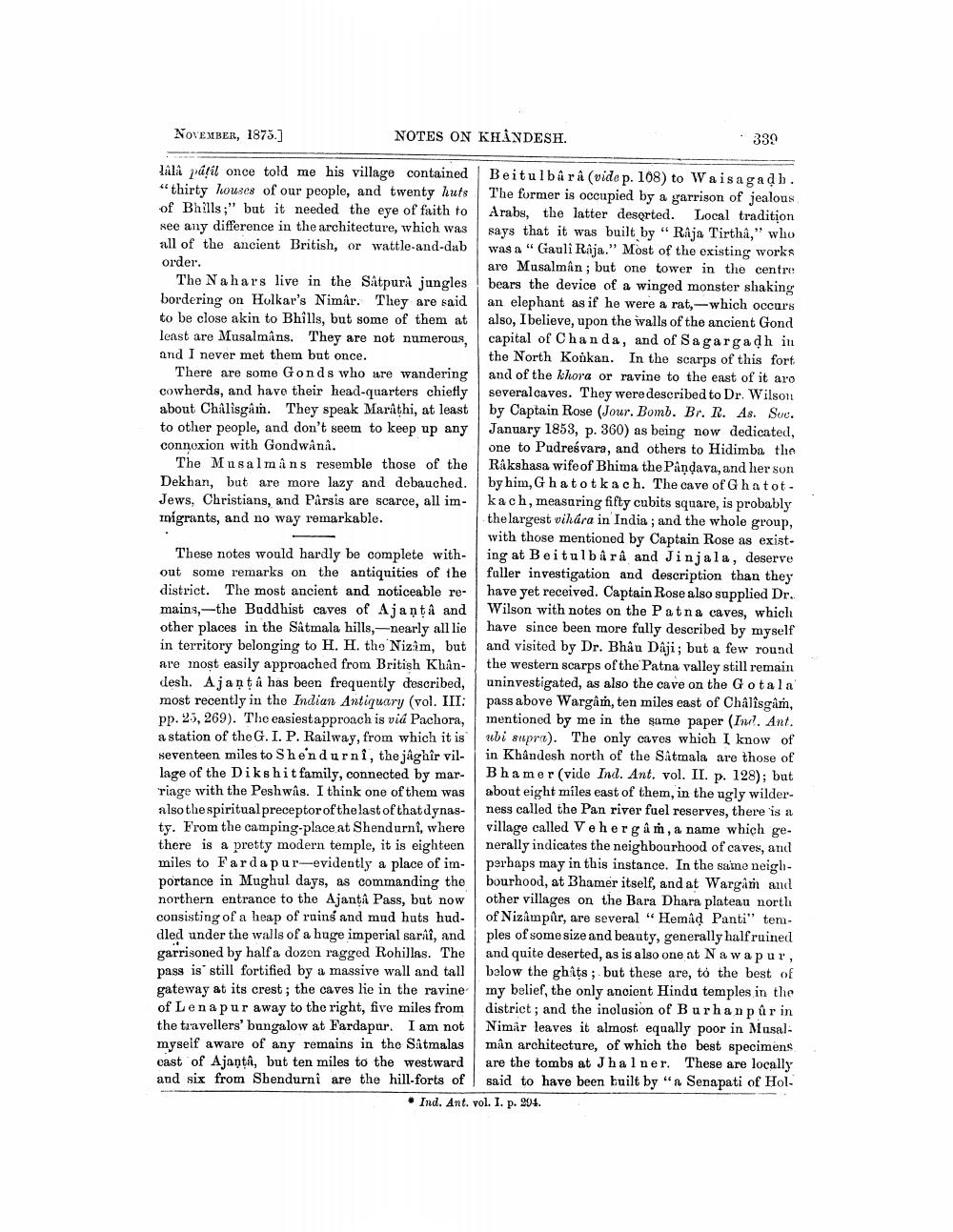________________
NOVEMBER, 1875.]
NOTES ON KHÂNDESH.
. 339
Jala prátil once told me his village contained Beitulbâ rå (vide p. 108) to Waisagadb. "thirty houses of our people, and twenty huts The former is occupied by a garrison of jealous of Bhills;" but it needed the eye of faith to Arabs, the latter deserted. Local tradition see any difference in the architecture, which was
says that it was built by “Raja Tirthå," who all of the ancient British, or wattle-and-dub was a " Gauli Raja." Most of the existing works order.
are Musalman; but one tower in the centre The N a hars live in the Satpurà jungles bears the device of a winged monster shaking bordering on Holkar's Nimar. They are said an elephant as if he were a rat, which occurs to be close akin to Bhills, but some of them at also, I believe, upon the walls of the ancient Gond least are Musalmans. They are not numerous, capital of Chanda, and of Sagargadh in and I never met them but once.
the North Konkan. In the scarps of this fort There are some Gonds who are wandering and of the khora or ravine to the east of it aro cowherds, and have their head-quarters chiefly several caves. They were described to Dr. Wilson about Châlisgâm. They speak Marathi, at least by Captain Rose (Jour. Bomb. Br. R. As. Sue. to other people, and don't seem to keep up any January 1853, p. 360) as being now dedicated, connexion with Gondwana.
one to Pudreśvara, and others to Hidimba the The Musalmans resemble those of the Rakshasa wife of Bhima the Pandava, and her son Dekhan, but are more lazy and debauched. by him, Ghatotkach. The cave of Ghatot. Jews, Christians, and Parsis are scarce, all im- kach, measuring fifty cubits square, is probably migrants, and no way remarkable.
the largest vihara in India, and the whole group,
with those mentioned by Captain Rose as exist. These notes would hardly be complete with- ing at Beitulbârâ and Jinjala, deserve out some remarks on the antiquities of the faller investigation and description than they district. The most ancient and noticeable re- have yet received. Captain Rose also supplied Dr. mains, the Buddhist caves of Ajanta and Wilson with notes on the Patna caves, which other places in the Satmala hills,-nearly all lie have since been more fully described by myself in territory belonging to H. H. tho Nizim, but and visited by Dr. Bhâu Daji; but a few round are most easily approached from British Khan- the western scarps of the Patna valley still remain desh. Ajant á has been frequently described, uninvestigated, as also the cave on the Gotala most recently in the Indian Antiquary (vol. III: pass above Wargam, ten miles east of Châlîsgam, pp. 25, 269). The easiest approach is vid Pachora, mentioned by me in the same paper (Inl. Ant. a station of the G. I. P. Railway, from which it is ubi supra). The only caves which I know of seventeen miles to Shendurni, the jaghir vil- in Khandesh north of the Satmala are those of lage of the Dikshit family, connected by mar- Bhamer (vide Ind. Ant. vol. II. p. 128); but riage with the Peshwas. I think one of them was about eight miles east of them, in the ugly wilderalso the spiritual preceptor of the last of that dynas- ness called the Pan river fuel reserves, there is a ty. From the camping-place at Shendurnî, where village called Veherg âm, a name which gethere is a pretty modern temple, it is eighteen nerally indicates the neighbourhood of caves, and miles to Fardapur-evidently a place of im- perbaps may in this instance. In the same neighportance in Mughul days, as commanding the bourhood, at Bhamer itself, and at Wargam and northern entrance to the Ajanta Pass, but now other villages on the Bara Dhara plateau north consisting of a heap of ruins and mud huts hud- of Nizampar, are several "Hemid Panti" temdled under the walls of a huge imperial sarii, and ples of some size and beauty, generally half ruined garrisoned by half a dozen ragged Rohillas. The and quite deserted, as is also one at Na wapur, pass is still fortified by a massive wall and tall below the ghits; but these are, to the best of gateway at its crest; the caves lie in the ravine my belief, the only ancient Hindu temples in the of Lenapur away to the right, five miles from district; and the inclusion of Burhan pûr in the travellers' bungalow at Fardapar. I am not Nimir leaves it almost equally poor in Musalmyself aware of any remains in the Satmalas mân architecture, of which the best specimens east of Ajanta, but ten miles to the westward are the tombs at Jhalner. These are locally and six from Shendurni are the hill.forts of said to have been built by "n Senapati of Hol.
• Ind. Ant. vol. I. p. 204.




